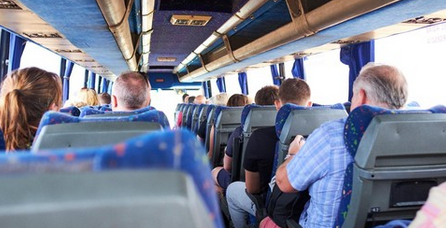Bus transport overview
Bus transport in the Republic of Slovenia primarily occurs as a public scheduled passenger transport in internal road transport. It takes place between bus stations and stops on a specific line, according to a predetermined timetable, general conditions and price list.
In addition to the public scheduled passenger transport, it also occurs as a special scheduled transport (transportation of workers between home and work), occasional transport (tourist agency) or as a permanent shuttle transport.
Other parts of the bus transport in Slovenia are public scheduled passenger transport in international road transport, scheduled transit passenger transport and passenger transport with alternating journeys.

Bus transport in the Slovenia is, next to rail transport, the most important for ensuring the transport of passengers in public passenger transport. As means of transport, buses are an affordable, safe, comfortable and environmentally friendly way of transport.
Biggest bus companies in Slovenia are Arriva, Nomago and LPP.
Buses transport 2x more passengers and cover 2x fewer passenger kilometres
Buses in intercity public scheduled transport, which is performed as a public economic service, are the most important means of public passenger transport in Slovenia.
In the first half of 2023, buses in intercity public scheduled transport transported more than 13.5 million passengers. Trains, on the other hand, carried only slightly more than 7.6 million passengers. There were almost 80% more passengers in intercity public scheduled transport than in rail transport (Source: Statistical Office of the Republic of Slovenia).

In the first half of 2023, trains covered as many as 450.6 million passenger km, while buses in intercity public scheduled transport covered only 261.5 million passenger km. More than 70% more passenger kilometres were travelled in railway public transport (Source: Statistical Office of the Republic of Slovenia).
As a means of public passenger transport, buses are therefore the most important for passengers, and bus transport is the most efficient.
Bus stations in the Republic of Slovenia
Bus stations in Slovenia are traffic areas in city municipalities where the arrivals and departures of buses and passengers, the sale and pre-sale of tickets and reservations, collection and storage of luggage, provision of information about transport and other services related to passenger transport are carried out.
Bus stops are all other traffic areas where, in accordance with the timetable, buses in public regular passenger transport stop.
There are 12 city municipalities in the Republic of Slovenia (Celje, Koper, Kranj, Krško, Ljubljana, Maribor, Murska Sobota, Nova Gorica, Novo mesto, Ptuj, Slovenj Gradec, Velenje).
The municipality of Ljubljana is the municipality with the largest number of inhabitants in Slovenia. Its centre, the city of Ljubljana, is also the capital of the country.
39% of the entire population of city municipalities lives in the municipality of Ljubljana. The city of Ljubljana is visited by 50% of all tourists that visit city municipalities. The municipality of Ljubljana has a 50% share of all workplaces in all city municipalities (Source: Statistical Office of the Republic of Slovenia).
The bus station in Ljubljana, managed by the company Avtobusna postaja Ljubljana, d. d., is the busiest bus station in Slovenia. It records almost a third of events (arrivals and departures of buses) in public scheduled passenger transport in domestic road transport and most events in public scheduled passenger transport in international road transport.
Due to its central location in the Republic of Slovenia and at the junction of two important European corridors (V. and X. pan-European corridors), the bus station in Ljubljana is an important bus hub for bus operators, both in domestic and international road traffic, as it connects SE Europe with the rest.
